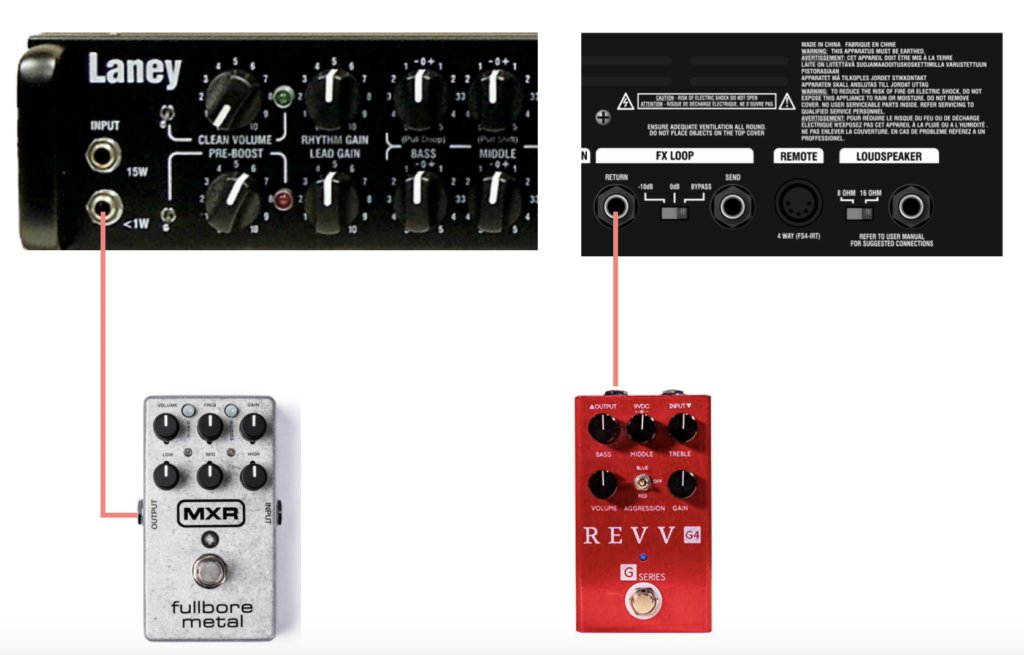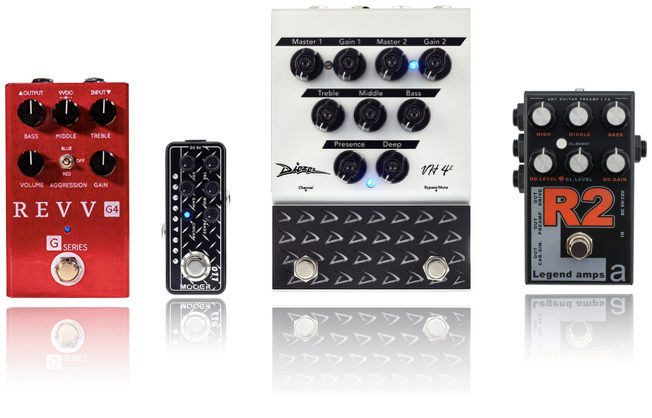Introduction
Many preamp and distortion pedals are available on the market nowadays : from very affordable pedals to the most expensive ones. They have become very popular : some guitar players use them to compliment their existing gear and amps in order to access new sounds, other might use them as their main gear for distorded sounds. For the beginners who are discovering these pedals or for the ones that envision to buy one, here is a small introduction on how to use them, especially when combined with impulse responses.
Distortion or preamp pedal ?
It’s not so easy to really make the difference between the two : some vendors use the word “preamp”, others name them distortion pedals. In both cases – in a metal world – these terms designate a pedal which will produce a distorted sound, typically plugged into a guitar amp, a power amp or a sound card.
After a little search and some gear experiments, I suggest that we differentiate them in the following way :
- “classical” distortion pedals are intended to be plugged into a guitar input on a guitar amp, and be used on the clean channel of the amp.
- preamp pedals are designed to act in a similar way to your amp’s preamp section : it will generally be plugged to your amp’s power amp input (FX loop return). The sound may be less balanced if you plug them directly to the guitar input and go through the clean channel.
So, in general, distortion pedals and preamp pedals will provide a different ‘colour’ or voicing, and distorsion pedals may clip the signal harder.

Note: some distortion pedals may be connected to the power amp directly and still sound great ! It really depends on the specific pedals voicing and the settings you use. So, in the end, making the distinction between the two is not always easy 😉
With a guitar amp
As explained, the preferred connection of a preamp pedal would be by using the FX loop return, so that the signal enters directly the power amp section. In this setting, the preamp volume control is your main volume control if your amp does not have a master volume control. Nothing prevents you from experimenting and try to plug your preamp to your guitar input : in my small experience, I get a more balanced and manageable sound by using the FX loop return.
If you do not have a guitar amplifier, there might be interesting alternatives such as small dedicated power amp like the Baby Bomb from Mooer (pedal format) or the Seymour Duncan PowerStage.
Without a guitar or power amp
We could imagine two scenarios:
- the pedal is plugged directly to your sound card, for example : overdrive pedal -> preamp pedal -> sound card -> and then a cab simulation with an impulse response loader (software)
- the pedal is plugged to a hardware impulse loader, for example : overdrive pedal -> preamp pedal -> hardware impulse loader, such as a Two-Notes CAB M.
When testing and practicing with such a setup, I am often confronted to a synthetic, dull or harsh sound, that would lack punch and realism. And quite often one of the remedy to this is to add the colour given by the power amp section of a guitar amp.
The power amp simulation can be added to your signal to colour your tone in a realistic way.
Note : you might not always need this power amp simulation to get great tone from your preamp pedal, it depends as well on the impulse response used and the tone obtained directly from the preamp and your pickups.
Power amps ?
The power amp section is the last one in a guitar amp, it will increase the output volume to drive the cab speakers. In tube power amps, different kinds of tubes are used, with different voicing and behavior. The choice of tube type and the way they are implemented strongly impact the overall tone (associated transformers, bias level, …. ) . The tubes frequently used in guitar amps are the following:
- 6L6 : 30 watts max (x4 = 120 Watts), typically the big massive American sound, used in big and powerful amps such as Mesa Dual Rectifiers, Peavey 6505’s or the Revv Generator 120 for example.
- 6V6 : 14 w max (x2 = approx 28 W), little cousin of 6L6’s, American sound, used in less powerful amps, such as the Mesa Boogie Fillmore, the Super Champ Fender or amps like the Randall Diavlo RD20
- EL34 : 25 watts max (x4 = 100 Watts), typical British sound, used in Marshall amps, Orange or some EVH amps
- EL84 : 12 watts (x2 = approx 24 watts), British sound, used by Vox. This tube type can be found on many « small » high-gain amps: Mesa Mark Five, Hughes&Kettner, Jet City Amplification, Engl E606, Laney IRT Studio, Peavey 6505 Mini, Orange amps…
- KT77 : can replace an EL34, less coloring. Found on Diezel amps.
- 6550 : less common, the Engl Savage use these.
- KT88 : less coloring, can be a substitute to 6550

To get a good overview of power amp tubes, check this page : https://www.premierguitar.com/articles/22739-power-trip-a-guide-to-power-tubes-and-their-signature-sounds.
Another very interesting post, in the same vein : https://www.seymourduncan.com/blog/the-tone-garage/know-your-amp-different-kinds-of-tubes with two videos where power tubes are swapped and tested, one with a 50 watts Orange amp et the other with a Randall Satan.
To understand better the impact of power amp tubes:
In order to get this specific tone change with impulse responses, you can either use a dedicated plugin (when using a computer with a DAW for example), or you can use the power amp simulations available with some impulse responser loader (Wall of Sound, Torpedo Live, Torpedo Cab M, or Mooer Radar for example).
Power amps Two-Notes
The Two-Notes Wall of Sound plugin embeds a section dedicated to power amp simulation (their hardware counterparts – Torpedo Live, CAB M – have the same feature). If offers no less than 4 different simulations and for each of them, two modes : push-pull ou single-ended.
The available simulations are :
- 6L6
- EL34
- EL84
- KT88

Another option is available : you can select pentode or triode mode. This parameter impacts the type of distortion associated with the simulation.
3 buttons allow you to adjust the main simulation parameters :
- Volume : how loud is the amp sim over your source signal. This will impact the overall volume of the plugin (or the Two-Notes hardware)
- Presence : somewhat similar to an amp presence, it controls how much of the frequency spectrum of your source signal is affected. Higher settings produce more clarity.
- Depth : somewhat similar to the depth or resonance setting of an amp. Affects mostly the low-end part, and controls the resonance added to the signal.
This three settings define the simulation behavior and how much “colour” or “power amp character” is affecting your signal, so that it can range from a very subtle to a very strong impact. You will probably need to adjust your input/output levels when you change these power amp settings, and specifically the volume parameter of the simulation. I personally enjoy using push-pull and pentode with 6L6, EL34 and KT88 simulations.
The riffs and partial song covers presented here as samples are used for illustration and educational purposes (using amps and IRs). These riffs and songs remain the property of their copyright owners.
Three small samples done with :
- EMG81
- MaxonOD808
- RevvG4
- Power Amp WOS
- WOS et IR Overdriven Fatboy G12K100 (E906)
Revv G4, Two Notes KT88
Revv G4, Two Notes EL34
Revv G4, Two Notes 6L6
Plugin Ignite TPA-1
This plugin from Ignite is quite unique as it is dedicated to power amp simulation (if you are aware of other similar plugins, please leave a comment).
Site de IgniteAmps : http://www.igniteamps.com/, TPA-1 : http://www.igniteamps.com/#tpa-1
When using a computer and a DAW, this plugin can be placed before the impulse response loader :

The TPA-1 plugin simulates a class AB power tube amp. 3 different simulations are available :
- EL34
- 6L6
- KT88
TPA-1 main controls screens, with typical controls (Volume, Depth, Presence):

As for the “rear” panel:

Ignite recommends using the oversampling feature in order to limit “numeric artefacts”.
A few explanations on the different settings (taken from the plugin documentation) :
- Bias settings : the tone becomes more or less percussive and defined (compressed)
- Feedback: lower values give a raw sound, higher values give a more moden tone. Directly impacts Presence and Depth settings.
- Sagging: tube compression behavior
- Resonance : adds low and high frequencies, with mediums more or less scooped.
The resonance can be used to “warm-up” some flat or dull IRs, missing body and punch otherwise.
Note : this resonance controls looks similar to the one added by Ignite to their Nadir v2 impulse response loader.
Conclusion
Using preamp pedals allow guitar players to access new tones and distortions effects and voicing. Selecting adapted impulse responses and using power amp simulations can provide great results !
Continue reading
Previous post : Impulse responses : part 3 (IR basics)
Next post : Impulse responses : part 5 (power amps)
Bonus : Lasse Lammert Mago DI pack
Here are two examples of a track from Lasse Lammert, reamped with the following gear : OD808, Revv G4 preamp, Torpedo WOS and an IR Overdriven.fr Zilla Fatboy G12K100 E906. Two versions are provided : 6L6 and KT88.
Lasse Lammert Mago DI – Revv G4, Two Notes KT88
Lasse Lammert Mago DI – Revv G4, Two Notes 6L6
You can find this pack in the links of this video : https://www.youtube.com/watch?v=GVWjtGGvBrk
Lasse Lammert YouTube Channel : https://www.youtube.com/user/LasseLammert

2024-04-14 at 14:47
Hi,
Question, my Zoom G11 pedal has separate sections for Cabsimms and IR’s.
It’s not clear to me how/where to use them, cabsim into a guitaramp, IR into PA/mixingdesk or should I combine a cabsim with an IR for the same cab?
Please shine your light on this.
I know, in the end it’s all about what sounds good but I love to have more info.
Regards,
Bas
2024-04-19 at 22:32
Hello Bas,
I don’t own a G11, but if Leo is correct in this video (https://www.youtube.com/watch?v=FdtYhwviFWQ), I believe that cab Simm blocks are similar to an IR block, simply preloaded with a switch between an SM57 and MD421….
Best regards,
David